Fear Matters
Halloween can scare kids and make them act strange. But animals and ecosystems respond to fear every day of the year.
Halloween is a spooky time of year. After hearing all the scary stories and seeing all the scary costumes, you might start to imagine ghosts lurking in the shadows, witches flying across the sky, and skeletons dancing in graveyards. You probably wouldn’t be surprised if a goblin jumped out from the bushes during recess and shouted, “Boo!”
 |
|
Even kids who know that ghosts aren’t real can get scared on Halloween.
|
| Carole Pasquier/Wikipedia |
Even if you’ve never been afraid of the dark, you might find yourself looking for monsters under the bed and sleeping with a night-light on as the end of October approaches. If so, don’t feel you’re acting like a coward. It’s perfectly normal to change your behavior when you feel afraid. After all, animals do it too.
“Fear matters,” says Karen Warkentin, a Boston University ecologist. “It’s a good thing,” she adds, “because fear makes you do things that keep you alive.”
Spooked frogs
Like kids, many animals experience fear. And they respond to the feeling in a variety of ways. Antelope on the plains of Africa, for example, run at the sight of a lion. A frightened turtle pulls its head and legs inside its shell. And small fish swim away when a big, hungry fish approaches.
Some animals respond to fear in ways you might not expect. The fear of being eaten, for instance, can scare some frogs right out of their eggs. Warkentin made that surprising discovery several years ago while studying tropical red-eyed treefrogs in Costa Rica.
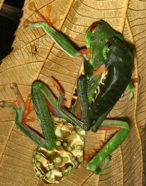 |
|
The Costa Rican red-eyed tree frog lays its eggs in a jellylike mass on the undersides of leaves.
|
| Karen Warkentin |
In this species, female frogs attach jellylike clumps of their eggs to the undersides of leaves. The leaves hang on branches that dangle over ponds. When embryos hatch from the jellylike mass of eggs, tadpoles tumble into the water, where they eventually grow into adult frogs.
Treefrog eggs usually grow for 6 days before hatching. If the embryos sense that a hungry snake is about to attack, however, they can hatch up to 2 days ahead of schedule. Their snake predators can’t swim. So, by falling into the water early, the tadpoles escape the serpents’ hungry jaws.
How can unborn frogs know that a snake is about to attack? Warkentin looked for an answer to that question by experimenting with frog eggs in her laboratory.
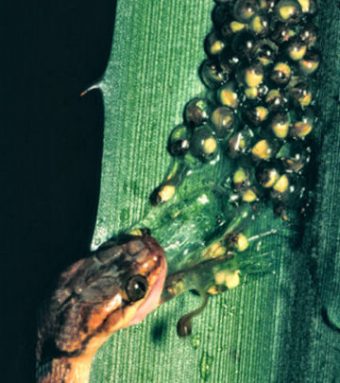 |
|
A hungry cat-eyed snake attacks a sticky mass of tree frog eggs. To the right of the snake’s head, you can see a tadpole hatching early and escaping to the relative safety of a pond below.
|
| Karen Warkentin |
An approaching snake, she discovered, produces vibrations separated by brief pauses. When Warkentin shook a clump of frog eggs in a similar pattern, the embryos came tumbling out.
Other sound patterns, such as the pitter-patter of rain or the continuous shaking of a landing bird, didn’t seem to scare the embryos, and they stayed put. Warkentin concluded that treefrogs can both detect vibrations and recognize when the motion is coming from a snake.
If hatching early helps protect red-eyed treefrogs from snakes, you might wonder why their eggs don’t always hatch sooner. It turns out that hatching early brings its own dangers.
Once tadpoles land in the water, hungry fish, shrimp, and other animals like to eat them too. Staying in their eggs for a full 6 days, then, allows frog embryos to grow big and strong. This extra growth improves their odds of surviving in the water.
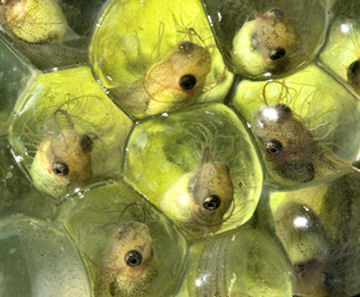 |
|
Tree frog embryos have plenty to fear, including hungry snakes on land and other predators in the water.
|
| Karen Warkentin |
In a snakefree environment, in other words, it makes the most sense for a frog embryo to wait 6 days before hatching. But, Warkentin points out, “If staying in the egg means you’re going to be eaten by a snake, you might as well find out what’s in the water.”
Ecology of fear
Fear can do more than affect animal behavior. It can actually influence entire ecosystems, say forest ecologists William Ripple and Robert Beschta of Oregon State University in Corvallis.
In Wyoming’s Yellowstone National Park, for example, the whole food web shifts when there are wolves around for the elk to worry about.
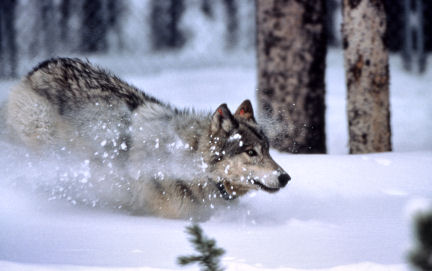 |
|
Fear of predators, such as this wolf in Yellowstone National Park, can cause an entire ecosystem to shift.
|
| Barry O’Neill |
Grey wolves eat elk. And there used to be lots of wolves in the park. Then, in the 1920s, wolves were removed from the area. As a result, the elk population exploded. Aspen trees in the park began to suffer because the large elk population was eating young trees before they had a chance to mature.
In the mid-1990s, scientists reintroduced wolves to the park. They expected that elk numbers would drop and aspen numbers would rise. Instead, a surprising sequence of events followed.
The elk population declined somewhat, but remained large enough to damage the aspens. Nevertheless, aspen trees returned to parts of the park where they hadn’t grown for years, Ripple and colleagues reported last summer.
So, how is it that young aspen trees are surviving, even as the elk population continues to thrive?
Ripple and Beschta suspect the park’s elk change their diets when they face an elevated risk (and fear) of being eaten themselves. Rather than munching on young aspen trees growing near streams, elk are spending more time on hills where they can easily see approaching wolves. Elk are also retreating deeper into the forest, where wolves are less likely to spot them.
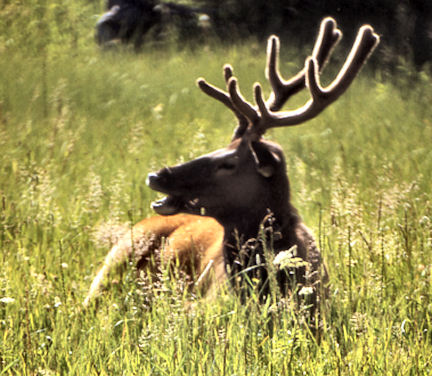 |
|
Elk in Yellowstone National Park have a lot more to fear now that wolves are back.
|
| NPS Photo by John Brandow |
“With wolves back in the ecosystem,” Ripple says, “The elk become more wary, more vigilant, and much more careful as to where they go and where they browse and graze.”
He calls this ecosystem-wide phenomenon an “ecology of fear.” It’s possible, he says, that similar relationships shape food webs all over the world.
“There are probably many interconnections and functions that we don’t know about yet,” he adds.
It’s important that wildlife managers recognize that a predator like a wolf can affect plants, even when it doesn’t eat them, Ripple says. In Yellowstone, for example, it wasn’t necessary to kill elk in order to protect the aspens.
Sometimes, Warkentin says, with animals like these, “You just have to scare them.”
Going Deeper:







